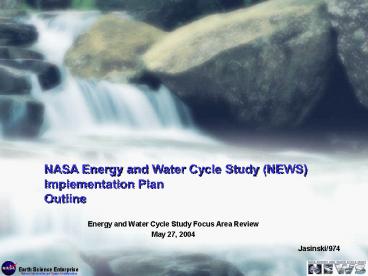Energy and Water Cycle Study Focus Area Review PowerPoint PPT Presentation
1 / 11
Title: Energy and Water Cycle Study Focus Area Review
1
NASA Energy and Water Cycle Study (NEWS)
Implementation Plan Outline
- Energy and Water Cycle Study Focus Area Review
- May 27, 2004
Jasinski/974
2
Motivation
- What are the causes of water cycle variations?
- Are variations in the global and water cycle
predictable? - How are water and nutrient cycles linked?
NASA-ESE Water Energy Cycle Science Ques (7
of 24) - How are global precip, evaporation and
the cycling of water changing? - What are the
effects of clouds and surface hydr. procs on
Earths climate? - How are variations in local
weather, precipitation and water resources
related to climate variation? - What are the
consequences of climate change and increased
human activities for coastal regions? - How
can weather forecast duration and reliability be
improved? - How can predictions of climate
variability and change be improved? - How will
water cycle dynamics change in the future?
3
Current Knowledge and Major Uncertainties What
we know global atmospheric and surface
temperature distributions top-of-the-atmosphere
radiation fluxes point processes What we
need to know global precipitation and water
vapor distributions cloud radiation absorption
and scattering properties global soil
moisture, snow cover/depth distributions
surface runoff evaporation land
surface/atmosphere feedbacks uncertainties in
integrated EWC processes
4
NASA Energy and Water Cycle Study (NEWS) NEWS
is the primary mechanism for implementing the
Energy and Water Cycle Focus Area. Its goal
is To document and enable improved,
observationally-based, predictions of energy and
water cycle consequences of Earth system
variability and change
5
NEWS Objectives
- NEWS research will promote and/or enable a
continuum of objectives through incremental
advances and breakthroughs over an extended
period - Focus on water and energy cycle processes
- Develop and deploy experimental EWC global
observing system - Document the global EWC by obtaining complete
observational record of all - associated relevant geophysical properties
- Build fully interactive global climate model
that encompasses process-level - EWC forcings and feedbacks
- Create global surface and atmosphere data
assimilation system for EWC variables - Assess variability of the global EWC on time
scales ranging from seasonal to - decadal, and space scales ranging from regional
to continental to global - Support the application of climate prediction
capabilities for estimating the - impact of climate variability and change on
water resources
6
NEWS implementation will include
- Product-driven investigations
- - Combine and interpret past and current
observations - - Derive global analysis and prediction tools and
products, - - Identify technological and observational
requirements to guide future NASA investments. - Independent discovery-driven investigations
- Explore scientific EWC frontiers
- Improving NASAs base capabilities and knowledge
Earth system EWC - Examine cross-cutting boundaries of current ESE
disciplinary programs. - A NEWS Science Integration Team
- Interfaces with other ESE research foci and
activities - Coordinates the NEWS investigations,
- Identifies/leads specific studies needed for
integration of the results of independent
product-driven or discovery-driven
investigations.
7
NEWS Strategy Phase-1 Exploits current
capabilities and prepares for future developments
of NEWS program elements (5 years) Phase-2
Addresses deficiencies and builds a viable
"prediction" system (5 - 7 years) Phase-3
Aims to deliver end-to-end system to address the
ESE vision (about 3 years)
8
Linkages Between Energy and Water Cycle and
Other Focus Areas, e.g. Climate
Water in the climate system functions on all time
scales (from hours to centuries)
- Energy and Water Cycle /Climate Linkage
- Earths climate primarily driven by solar forcing
and terrestrial radiation processes - Key feedbacks affecting climate sensitivity are
water vapor and cloud-radiation processes - Terrestrial hydrologic processes impact climate
- Changes in precipitation patterns and
intensity, represent the most serious
manifestation of climate variability and change
- Focus Area Linkage
- Generally CVC Focus Area will handle longer-term
energy and water processes Ocean (dynamics) and
Ice (glaciers, sea ice, ice sheets), sea level
rise - Generally EWC Focus Area will handle
shorter-term energy and water processes
Precipitation, Evaporation, land-atmosphere
interaction, radiation balance, etc. - Coordinated linkages Clouds
9
NEWS Status Draft NEWS Implementation
Plan Draft NEWS NRA Satellite
Systems in place GPM, HYDROS, CLOUDSAT
10
Outstanding Issues Observations Uncertain
deployment schedule for comprehensive energy and
water observing system (e.g. GPM, HYDROS) Lack
of coordinated, and consistent long-term, global
data sets Modeling Limited capabilities to
assimilate key energy and water
variables Institutional Lack of support for
full interagency coordination
11
NASA Energy and Water Cycle (NEWS) Road Map

